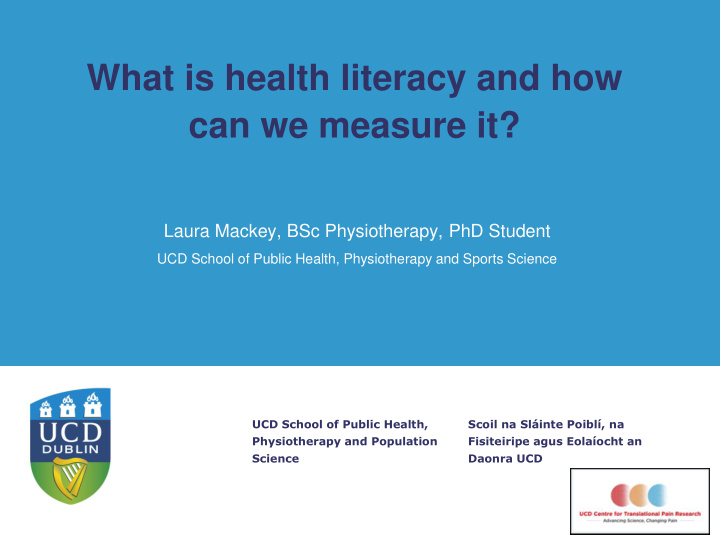



What is health literacy and how can we measure it? Laura Mackey, BSc Physiotherapy, PhD Student UCD School of Public Health, Physiotherapy and Sports Science UCD School of Public Health, Scoil na Sláinte Poiblí, na Physiotherapy and Population Fisiteiripe agus Eolaíocht an Science Daonra UCD
Presentation Aims • Overview and definition of health literacy. • Understand the evolving nature of health literacy – definitions to conceptual frameworks. • Impact of low health literacy. • Health literacy assessment tools. • Management strategies in a clinical setting.
Health Literacy Definitions • ‘the degree to which individuals have the capacity to obtain, process & understand basic information & services needed to make appropriate decisions about their health’ (IOM, 2004). • ‘the cognitive & social skills which determine the motivation and ability of individuals to gain access to, understand & use information in ways which promote and maintain good health’ (WHO, 1998) .
Health Literacy – Clinical Perspective Patient HCP skills/capacities skills/capacities • Language used • Prior knowledge • Communication • Understanding • Assessment • Confidence • Written material • Decision-making • HL Interventions • Motivation • Building/signage • Cognitive skills
Models/Conceptual Frameworks • Baker, 2006 • Paasche-Orlow and Wolf, 2007 • Nutbeam, 2008 • Von Wagner et al, 2009 • Sorensen et al, 2012 • Squiers et al, 2012
Paasche-Orlow & Wolf, 2007
Squiers et al, 2012
HLS-EU Survey
Why Health Literacy?
Self-management
Examples • https://www.youtube.com/watch?v=p- x8XgfGwDs • https://www.youtube.com/watch?v=QUS- qy2jV1U
Healthcare professionals’ role.. Educators • Communicate effectively with patients. • Traditional passive approach vs. Biopsychosocial. • Need patients to ‘buy’ into our treatment strategies. • Via: - Self-management development. + HEALTH LITERACY - Motivation, desire, and volition. DEVELOPMENT. - Shared decision making. - Goal orientated treatments.
Who is at risk? • Older adults. • Lower SES. • Lower educational attainment. • Ethnic minorities. • Non-English speaking. • Beware!! – higher education does not always suggest adequate health literacy.
Common Red Flags.. • ‘I forgot my glasses…’ • ‘I’ll take the form home with me…’ • ‘My son sorts all that stuff out for me…’
How to assess? • Validated tools: Test of Functional Health Literacy in Adults (TOFHLA) (Parker et al, 1995). Rapid Estimate of Adult Literacy in Medicine (REALM) (Davis & Crouch, 1991). Newest Vital Sign (NVS) (Weiss et al, 2006). • Patient’s understanding of their condition? • Gut instinct – leads to overestimation of health literacy in patients? (Mackert et al, 2011).
Short test of functional health literacy (s-TOFHLA) (Baker et al, 1999). 4 sections: • Modified cloze procedure. • Reading comprehension. • Numeracy skills. Administration time: • 7 minutes.
Rapid Estimate of Adult Literacy in Medicine (REALM) (Davis & Crouch, 1991). 66 words: • Reading comprehension. • Pronunciation. Administration time: • 3 - 7 minutes.
The Newest Vital Sign (NVS) (Weiss et al, 2006). 6 questions: • reading comprehension • quantitative capacity • cognitive capacities (i.e. critical thinking) Administration time: • 3 minutes
Interventions • Plain English documents. • Teach back method. • Signage in hospitals / clinics. • Individual and/or group based education or counselling services (Taggart et al, 2011). • ? HL-sensitive interventions in COPD (Kiser et al, 2011) , and Coronary Artery Disease (Eckman et al, 2012).
In conclusion Health Literacy…. • Umbrella term for patient characteristics and attributes, that are necessary for the subsequent development of health related skills. • These skills enable people to build their knowledge, more skills, and potential to make positive and sustainable health behaviour changes of their own volition. •May be modifiable from patients’ experiences in health care settings • Healthcare professionals can positively facilitate this with suitable interventions and strategies. • Recognising low health literacy is important.
Recommend
More recommend